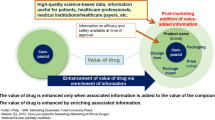Abstract
The publication number in pharmaceutics from Chinese academia globally ranked second in 2014. However, the R&D capability of Chinese pharmaceutical industry significantly lags behind its globally 2nd market with 373 billion USD. The study aims to analyze the gaps between Chinese academia and industry in pharmaceutics. Publication, national funding programs and postgraduate training were analyzed to identify the academic output. R&D expenses input, research scientists and marketed products were investigated to evaluate the industrial demand. The Chinese publication number in pharmaceutics grows sharply, ranking first globally in 2017. The hot fields from Chinese scholars focused on nanomedicine and gene delivery, while the majority of products in Chinese pharmaceutical companies were still conventional dosage forms (e.g. tablet, capsule and injection). On the other hand, the number of Ph.D. graduates in pharmaceutics maintained a quite low-level output from 2000 to 2018, which seriously unmet the growing demand of high-level formulation scientists from Chinese pharmaceutical industry. Furthermore, the development of Chinese drug administration system from 1978 to 2018 was detailed summarized, analyzed and discussed because the government policies strongly influence the academia and pharmaceutical industry. Two suggestions are provided to bridge the gaps between Chinese academia and pharmaceutical industry. On the one hand, Chinese universities should shift the academic evaluation system from publication-orientation to more diverse science and demand-driven researches. On the other hand, more industry-oriented Ph.D. graduates should be trained to meet the increasing demand from the pharmaceutical industry. As the second largest market in the world, Chinese pharmaceutical industry will face the enormous progress in next 5–10 years.








Similar content being viewed by others
Notes
China pharmaceutical industry economic operation report in (2018). http://www.lwzb.gov.cn/pub/lwzb/gzdt/201905/t20190521_5113.html.
Pharm exec's top 50 companies (2018). http://www.pharmexec.com/pharm-execs-top-50-companies-2018.
Center for Food and Drug Inspection of NMPA. http://www.cfdi.org.cn/resource/news/6794.html.
National Medical Products Administration. http://app1.sfda.gov.cn/datasearchcnda/face3/dir.html?type=yp.
National Medical Products Administration. http://www.nmpa.gov.cn/WS04/CL2200/334162.html.
China education funding statistics yearbook. (2017) http://www.yearbookchina.com/navibooklist-n3018062625-1.html.
National Natural Science Foundation of China http://www.nsfc.gov.cn/.
References
Banister, J. (2012). Population aging and economic growth in China. The Chinese economy (pp. 114–149). London: Palgrave Macmillan.
Bjornmalm, M. (2017). Bridging bio–nano science and cancer nanomedicine. ACS Nano,11(10), 9594–9613.
Brannon-Peppas, L. (2012). Nanoparticle and targeted systems for cancer therapy. Advanced Drug Delivery Reviews,64, 206–212.
Chaomei, C. (2006). Citespace II: Detecting and visualizing emerging trends and transient patterns in scientific literature. Journal of the American Society for Information Science Technology,57(3), 359–377.
Chen, H. (2011). Nanonization strategies for poorly water-soluble drugs. Drug Discovery Today,16(7–8), 354–360.
Chen, C. (2014). The citespace manual. Retrieved Octubre,12, 2014.
Chen, B., & Zhang, J. M. (2015). Media and public reactions toward vaccination during the ‘hepatitis B vaccine crisis’ in China. Vaccine,33(15), 1780–1785.
Dean, P. (2000). Building relationships between academia and the pharmaceutical industry. Drug Discovery Today,5(9), 377–378.
Garfield, E. (2006). The history and meaning of the journal impact factor. JAMA,295(1), 90–93.
Giliyar, C. (2006). Challenges and opportunities in oral delivery of poorly water-soluble drugs. Drug Delivery Technologies,6, 57–63.
He, C.-X. (2010). Microemulsions as drug delivery systems to improve the solubility and the bioavailability of poorly water-soluble drugs. Expert Opinion on Drug Delivery,7(4), 445–460.
Jing, Y., & Kelton, C. M. (2007). Lethal drug probe in China: The case of Xinfu clindamycin. Pharmacoepidemiology Drug and Safety,16(8), 928–932.
Lai, M.-N., & Lai, J.-N. (2010). Risks of kidney failure associated with consumption of herbal products containing Mu Tong or Fangchi: A population-based case–control study. American Journal of Kidney Diseases,55(3), 507–518.
Lipinski, C. A. (2012). Experimental and computational approaches to estimate solubility and permeability in drug discovery and development settings. Advanced Drug Delivery Reviews,64, 4–17.
Lulin, Z. (2016). The effect of herd formation among healthcare investors on health sector growth in China. International Journal for Equity in Health,15(1), 113.
Mooney, K. G. (2001). Challenges faced by the pharmaceutical industry: Training graduates for employment in pharmaceutical R&D. European Journal of Pharmaceutical Sciences,12(4), 353–359.
Peer, D. (2007). Nanocarriers as an emerging platform for cancer therapy. Nature Nanotechnology,2(12), 751.
Sethi, S. (2019). Indian pharmaceutical industry: Learning to crawl before it runs. Symbiosis,2012, 14.
Shapira, P. (2009). From lab to market? Strategies and issues in the commercialization of nanotechnology in China. Journal of Asian Business Management,8(4), 461–489.
Tian, M., Su, Y., & Ru, X. (2016). Perish or publish in China: Pressures on young Chinese scholars to publish in internationally indexed journals. Publications,4(2), 9.
Wang, J., & Chen, L.-Y. (2010). Demonstration of suspicious drugs in the methotrexate adverse drug event. China Pharmacy,2010(44), 35.
Wu, X. (2006). The transformation of biomedical industry in China: From academic affair to commercialization. Journal of Asia Business Studies,1(1), 16–25.
Wu, T., et al. (2010). Recommendations for reporting adverse drug reactions and adverse events of traditional Chinese medicine. Journal of Evidence-Based Medicine,3(1), 11–17.
Xiao, M., & Yingying, L. (2016). Discussion on the supervision problems and suggestions in the case of shandong vaccine. China Pharmacy,27(16), 2161–2163.
Yuan, X. (2018). China’s vaccine production scare. The Lancet,392(10145), 371.
Zhan, Q. (2015). Literature analysis of acanthopanax anaphylactic shock in China. Journal of Traditional Complementary Medicine,5(4), 253–257.
Zhang, M. (2012). Who will defend chinese dining tables—A review of Chinese Food Safety Law after the Sanlu milk scandal. Chinese Law Food Safety Milk Powder Scandals Food Industry.
Zhang, W., & Zhao, Q. (2017). Big data analysis of global advances in pharmaceutics and drug delivery 1980–2014. Drug Discovery Today,22(8), 1201–1208.
Zhong, H., et al. (2018). A comprehensive map of FDA-approved pharmaceutical products. Pharmaceutics,10(4), 263.
Acknowledgements
This research was funded by the cooperative construction of a bid data platform for Chinese Medicine CP-001-2018, Macau Science and Technology Development Fund (FDCT) (Grant No. 0029/2018/A1) and 2017 Sub-project 6 of National Major Scientific and Technological Special Project for “Significant New Drugs Development” (2017ZX09101001006) by the National Institute of Food and Drug Control.
Author information
Authors and Affiliations
Corresponding author
Rights and permissions
About this article
Cite this article
Zhong, H., Ouyang, D. The gap analysis between Chinese pharmaceutical academia and industry from 2000 to 2018. Scientometrics 122, 1113–1128 (2020). https://doi.org/10.1007/s11192-019-03313-7
Received:
Published:
Issue Date:
DOI: https://doi.org/10.1007/s11192-019-03313-7




